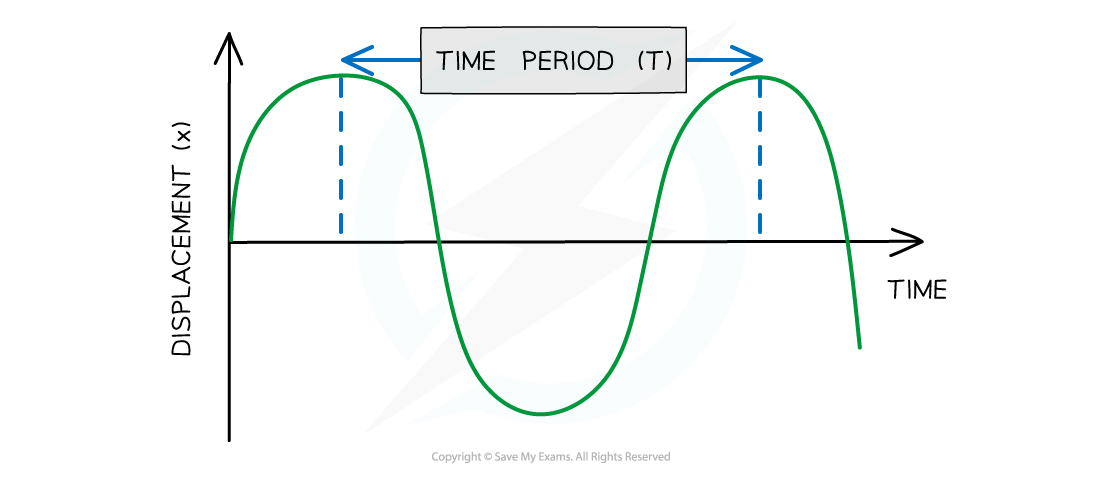Describing Oscillations (DP IB Physics): Revision Note
Properties of Oscillations
An oscillation is defined as follows:
The repetitive variation with time t of the displacement x of an object about the equilibrium position (x = 0)
The equilibrium position (x = 0) is the position when there is no resultant force acting on the object
This is the fixed central point that the object oscillates around

A pendulum oscillates between A and B. On a displacement-time graph, the oscillating motion of the pendulum is represented by a wave, with an amplitude equal to x0
A particle undergoing an oscillation can be described by the following properties:
displacement
amplitude
time period
frequency
angular frequency
Displacement
Displacement (x) is the horizontal or vertical distance of a point on the wave from its equilibrium position
It is a vector quantity
It can be positive or negative, depending on which side of the oscillation it is
It is measured in metres (m)
Amplitude
Amplitude (x0) is the maximum value of the displacement on either side of the equilibrium position
Amplitude is measured in metres (m)

When the pendulum is in its extreme position, this is its amplitude
Time period
Period (T) or time period, is the time interval for one complete oscillation measured in seconds (s)
If the oscillations have a constant period, they are said to be isochronous

Diagram showing the time period of a wave
Frequency
Frequency (f) is the number of oscillations per second and it is measured in hertz (Hz)
Hz has the SI units per second s−1 because
Angular frequency
Angular frequency (ω) is the rate of change of angular displacement with respect to time
It is measured in radians per second (rad s−1)
Worked Example
The diagram below shows plane waves on the surface of water at a particular instant. A and B are two points on the wave.

Determine:
(a) The amplitude
(b) The wavelength
Answer:

Examiner Tips and Tricks
When labelling the amplitude and time period on a diagram:
Make sure that your arrows go from the very top of a wave to the very top of the next one
If your arrow is too short, you will lose marks
The same goes for labelling amplitude, don’t draw an arrow from the bottom to the top of the wave, this will lose you marks too.
Calculating Time Period of an Oscillation
This equation relates the frequency and the time period of an oscillation:

The equation linking time period and frequency
Angular frequency (⍵) can be calculated using the equation:
Where:
⍵ = angular frequency (rad s-1)
2π = circumference of a circle
T = time period (s)
f = frequency of oscillation (Hz)
The angular displacement of objects in oscillation can be determined by matching the displacement to an object in circular motion:
After moving from one amplitude position x = −A to the equilibrium position x = 0, the mass on the spring has an angular displacement of
of a circle =
radians
Continuing the oscillation from the equilibrium position to the other amplitude position, the angular displacement is also
radians
Continuing the oscillation back to the starting point means the mass travels a further angular displacement of
radians
Hence, the total angular displacement in one oscillation is
radians

The motion of an oscillating object can be analysed in terms of a fraction of an object in circular motion
Worked Example
A child on a swing performs 0.2 oscillations per second.
Calculate the time period of the oscillation.
Answer:
Step 1: Write down the known quantities
Frequency, f = 0.2 Hz
Step 2: Write down the relationship between the period T and the frequency f
Step 3: Substitute the value of the frequency into the above equation and calculate the period
Worked Example
A cuckoo in a cuckoo clock emerges from a fully compressed position to a fully extended position in 1.5 seconds.
Calculate the angular frequency of the cuckoo as it emerges from the clock.
Answer:
Step 1: Consider the motion of the cuckoo
The cuckoo goes from being fully compressed to fully extended which means that it travels for an angular displacement of half a circle and not a full circle
So, the angular displacement will be π

Step 2: Substitute into the equation for angular velocity and time period
ω = =
= 2.09 rad s-1
Step 3: State the final answer
The angular frequency of the cuckoo as it emerges from the clock is 2.1 rad s-1 (2 s.f.)

Unlock more, it's free!
Did this page help you?